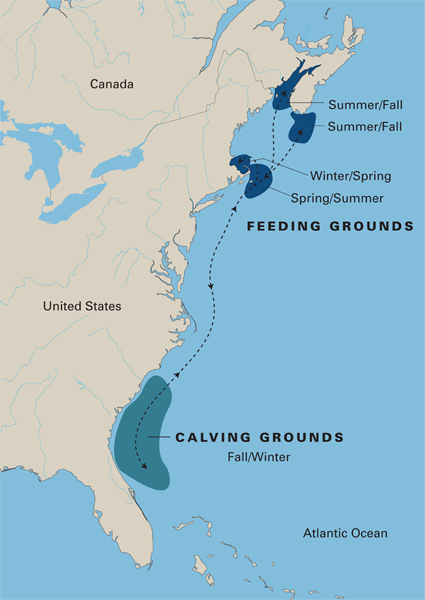Seismic survey planning work in an enormous area off the southern half of the Atlantic coast has been put on hold while federal fisheries managers review new information about potential harm to sea turtles and marine mammals.
Air-gun blasts are used to find oil and gas deposits under the ocean floor, but some biologists say that the concussive noise can disturb feeding, breeding and navigational behavior of protected whales and dolphins. New research has indicated that negative effects may affect larger numbers of animals for longer periods than previously understood.
Supporter Spotlight
“We are encouraged that both the National Marine Fisheries Service and BOEM (the Bureau of Ocean Energy Management) have taken the time to review the new science and really gain a new understanding of the eco-system in the Atlantic,” said Ingrid Biedron, marine biologist for Oceana, a nonprofit group opposed to the seismic exploration.
Eight permits accepted by BOEM are currently undergoing review by the fisheries service, said John Filostrat, a BOEM spokesman. Incidental Harassment Authorization, or IHA, permits must be approved by the service before BOEM can move forward. The permits, which allow a certain number of whales and dolphins to be harmed or killed – “takes” is the euphemism used in federal law — each year per species, are a critical step in approval of the seismic survey work.
“If they issue an IHA, then we continue our review and coordination process,” he said. “If the IHA was denied, then BOEM denies the permit.”
Filostrat said the current pause in planning should not be regarded as a glitch.

“This is part of the process and we’re going through it,” he said, adding he could not put a timeline on its anticipated completion.
Supporter Spotlight
The required environmental review for the proposed seismic work was finished in July 2013, but the need for additional review by the fisheries service was triggered recently by several proposals that would alter management rules for numerous marine species under Section 7 of the federal Endangered Species Act.
Proposed changes include designation of critical habitat for loggerhead sea turtles; expansion of critical habitat for the north Atlantic right whale; and adding, upgrading or removing ESA listings of the bigeye thresher shark, scalloped hammerhead shark, common thresher shark, the porbeagle shark, smooth hammerhead shark, humpback whale, Caribbean electric ray, green sea turtle and dwarf seahorse.
At the same time, the agency is also reviewing updated information on the density of marine mammals in the area where the tests will be done, as well as other recent studies about the effects of seismic noise on marine mammals.
“We always welcome new science,” Filostrat said.
One 2015 study on the bowhead whale’s response to air gun noise found that the pulsing sounds changed the way the animals communicate but to what extent is unknown.
According to the report, the study “has shown an unexpectedly complex change in bowhead whale calling behavior – first an increase, followed by a plateau, and then a decrease – to perceived levels from air gun sounds. “
The authors of another study released last year concluded that the amount of baseline data on seismic effects is insufficient for regulators to reach accurate conclusions about the risks to marine life.

“The process for permitting surveys must take these data needs into account,” the report said, “and be adjusted accordingly, and perhaps even paused while such information is gathered.”
Recent research has also shown that the numbers of estimated takes of marine mammals in the study area stretching from Delaware to Florida– an area about twice the size of California – is far more than BOEM had estimated in its 2013 environmental study because it relied on outdated information or inaccurate impact thresholds.
Scientists said in October that marine mammal takes may have been underestimated three-fold to as much as 15-fold.
Annual take estimates for most marine mammal species cited by BOEM typically numbered in the thousands, with bottlenose dolphins having the highest incidence.
In a letter signed by 75 marine scientists sent in March to the White House, high-volume air guns were blamed for disruptions in “activities essential to foraging and reproduction over vast ocean areas,” and for increasing stress and mortality for endangered whales and dolphins.
But the estimated 20 million seismic shots proposed in the Atlantic, the letter said, could also have serious effects for many years on all the animals in the area.
“Seismic surveys have been shown to displace commercial species of fish, with the effect in some fisheries of dramatically depressing catch rates,” the scientists wrote.
The noise can interfere with breeding, cause hearing loss, degrade predator responses, and disrupt breeding behavior and embryonic development in different species.
BOEM’s 2013 report noted 39 species of marine mammals within the target area, although four species of seal and the manatee are probably not currently in the “area of interest.”
Ben Laws, a NOAA Fisheries biologist who works under the Marine Mammal Protection Program, said there are five requests from different companies for authorization from his department, three of which were made available for public review in August.
Laws said that new density information being reviewed will compare the take numbers of individual species to the abundance of the overall population. He said that he expects the review will be completed in the first quarter of the year.
“We take it one step at a time,” he said.
The next step is publishing the proposed authorizations, which will detail the method of taking, specified activity, potential effects and proposed mitigation. There is a 30-day comment period.
Kellie Foster-Taylor, NOAA Fisheries biologist and national Section 7 coordinator, said that as part of the proposed listings, green sea turtles have been broken out into distinct populations within critical habitat. Also, humpback whales in the Atlantic where the testing will take place are proposed to be de-listed. The proposal would break the humpback into 14 distinct populations. Of them, four would be listed as endangered, four as threatened, and 10 would be de-listed. Another proposal would expand critical habitat for the right whale in the Atlantic.
Foster-Taylor said that fisheries biologists are studying, in part, how far the propulsive sound of the seismic blasts travel, as well as its potential effects. The agency is going back to review the biological opinion “to see that nothing has changed,” or to respond to new scientific information.
“Anytime you have sound involved, it’s complex,” she said.
Mitigation measures proposed by BOEM in its 2013 report included exclusion zones, closures of certain areas at certain times, passive acoustic monitoring and observer programs.
Biedron, who is an expert in whale acoustics, said that a lot is at stake for marine animals in whether seismic blasting is allowed to take place in the Atlantic. For instance, she said, the area under consideration includes the only known calving area in the world for the north Atlantic right whale, of which only 500 remain.
“Even the loss of two or three animals could endanger the health of that population,” she said.
Overall, cumulative and overlapping impacts on marine species, Biedron said, must be considered with use of such powerful and frequent blasts in the animals’ environment.
“We would encourage policy makers to explore alternative options,” she said.
Related Content
- Groups Say Seismic Survey Study Obsolete
- Extent of Seismic Tests Makes Feds Pause
- Scientists Urge Halt to Seismic Permitting








